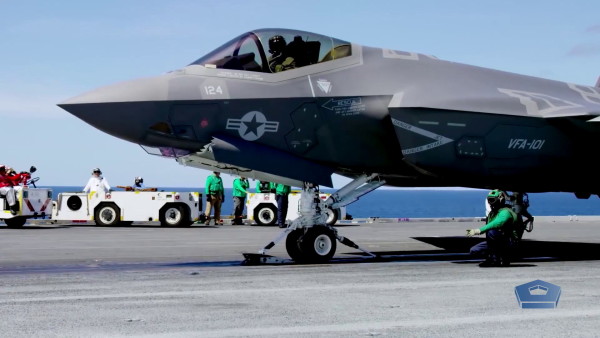

In February, the commander of the U.S. Naval Air Forces proclaimed that the Navy’s F-35C Joint Strike Fighter was “ready for operations, ready for combat and ready to win” — even though the Navy’s own testing data says otherwise.
Testing data obtained by the Project On Government Oversight (POGO) indicates that the F-35 variant’s “fully mission capable” rate — a key measure of a military aircraft’s readiness — collapsed from 12% in October 2016 to zero in December 2017 before remaining flat through 2018.
The Marine Corps’ F-35B hasn’t fared much better: According to the POGO report, the aircraft’s FMC rate fell from 23% in October 2017 to 12.9% in June 2018.
Both of these rates are far below the September 2019 target of an 80% mission capable rate for both Navy and Air Force fighter jets set by former Defense Secretary James Mattis back in October.
Two F-35C Lightning II aircraft from Naval Air Station Lemoore flown by Maj. Michael Fisher and Capt John Taliaferro from Strike Fighter Squadron (VFA) 125 “Rough Raiders” fly in formation over the Sierra Nevada Mountain Range after completing a training mission (NASL), Calif.

(U.S. Navy/Lt. Cmdr. Darin Russell)
These shortcomings come weeks after an annual report from the Pentagon’s operational testing and evaluation arm highlighted the alarmingly low service life of the F-35B that “may be as low as 2,100 ,” well bellow the expected service life of 8,000 hours.
According to POGO, these readiness shortfalls dramatically reduce the availability of aircraft and, in turn, the next-generation’s overall effectiveness downrange. From the report:
To tell how many planes can actually get to the fight requires a second measure, the sortie generation rate: that is, how many flights per day each fighter in the fleet completes. The 2018 DOT&E report makes no mention of it.
The fleet-wide sortie rates for the three F-35 variants POGO calculated from the 2017 report were extremely low, averaging between 0.3 and 0.4 sorties per day. During Operation Desert Storm, frontline combat aircraft including the F-15 and F-16 flew an average of at least one sortie per day, and the A-10 fleet averaged at least 1.4 sorties per day. Even under the pressure of recent Middle East combat deployment, the F-35’s rates have not improved. According to statements from the squadron commander, 6 F-35Bs onboard the USS Essex flew over 100 sorties in 50-plus days in the Middle East. In other words, each F-35B flew a third of a sortie per day—meaning they flew an average of once every three days—in sustained combat.
Despite this, Marine Corps F-35B flew more than 100 combat sorties against Taliban and ISIS targets from the amphibious assault ship USS Essex over 50 days after its combat debut in September 2018, Lt. Col. Kyle Shoop, commander of Marine Fighter Attack Squadron 211 previously told Task & Purpose.
And in February, the Navy declared that the F-35Cs assigned to the Strike Fighter Squadron (VFA) 147 had achieved initial operational capability and were ready to deploy.
“We will continue to learn and improve ways to maintain and sustain F-35C as we prepare for first deployment,” Joint Strike Fighter Wing commodore Capt. Max McCoy said at the time. “The addition of F-35C to existing Carrier Air Wing capability ensures that we can fight and win in contested battlespace now and well into the future.”